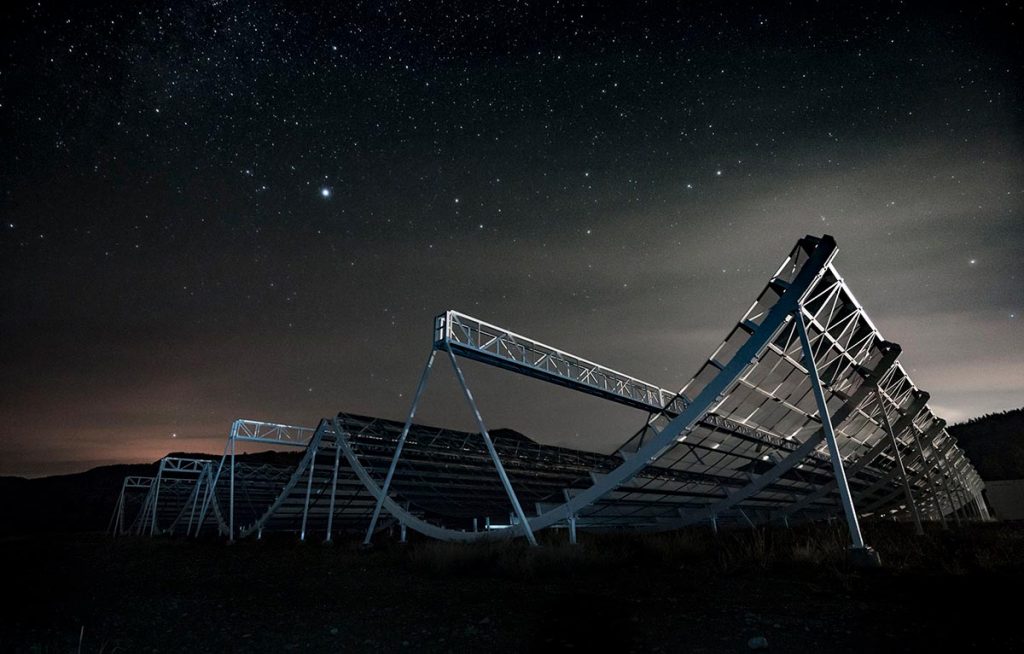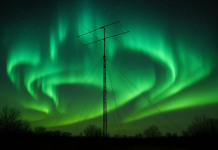CHIME telescope has detected more than 500 mysterious fast radio bursts in its first year of operation. Observations quadruple the number of known radio bursts and revealed two types: one-offs and repeaters.

To catch sight of a fast radio burst is to be extremely lucky in where and when you point your radio dish. Fast radio bursts, or FRBs, are oddly bright flashes of light, registering in the radio band of the electromagnetic spectrum, that blaze for a few milliseconds before vanishing without a trace.
These brief and mysterious beacons have been spotted in various and distant parts of the universe, as well as in our own galaxy. Their origins are unknown, and their appearance is unpredictable. Since the first was discovered in 2007, radio astronomers have only caught sight of around 140 bursts in their scopes.
New telescope, unprecedented results
Now, a large stationary radio telescope in British Columbia has nearly quadrupled the number of fast radio bursts discovered to date. The telescope, known as CHIME, for the Canadian Hydrogen Intensity Mapping Experiment, has detected 535 new fast radio bursts during its first year of operation, between 2018 and 2019.
Scientists with the CHIME Collaboration, including researchers at MIT, have assembled the new signals in the telescope’s first FRB catalog, which they will present this week at the American Astronomical Society Meeting.
Two classes of alien bursts
The new catalog significantly expands the current library of known FRBs, and is already yielding clues as to their properties.
For instance, the newly discovered bursts appear to fall in two distinct classes: those that repeat, and those that don’t. Scientists identified 18 FRB sources that burst repeatedly, while the rest appear to be one-offs. The repeaters also look different, with each burst lasting slightly longer and emitting more focused radio frequencies than bursts from single, nonrepeating FRBs.
These observations strongly suggest that repeaters and one-offs arise from separate mechanisms and astrophysical sources. With more observations, astronomers hope soon to pin down the extreme origins of these curiously bright signals.
“Before CHIME, there were less than 100 total discovered FRBs; now, after one year of observation, we’ve discovered hundreds more,” says CHIME member Kaitlyn Shin, a graduate student in MIT’s Department of Physics. “With all these sources, we can really start getting a picture of what FRBs look like as a whole, what astrophysics might be driving these events, and how they can be used to study the universe going forward.”
Seeing flashes
CHIME comprises four massive cylindrical radio antennas, roughly the size and shape of snowboarding half-pipes, located at the Dominion Radio Astrophysical Observatory, operated by the National Research Council of Canada in British Columbia, Canada. CHIME is a stationary array, with no moving parts. The telescope receives radio signals each day from half of the sky as the Earth rotates.
While most radio astronomy is done by swiveling a large dish to focus light from different parts of the sky, CHIME stares, motionless, at the sky, and focuses incoming signals using a correlator — a powerful digital signaling processor that can work through huge amounts of data, at a rate of about 7 terabits per second, equivalent to a few percent of the world’s internet traffic.
“Digital signal processing is what makes CHIME able to reconstruct and ‘look’ in thousands of directions simultaneously,” says Kiyoshi Masui, assistant professor of physics at MIT, who will lead the group’s conference presentation. “That’s what helps us detect FRBs a thousand times more often than a traditional telescope.”
Alien signals evenly distributed in space
Over the first year of operation, CHIME detected 535 new fast radio bursts. When the scientists mapped their locations, they found the bursts were evenly distributed in space, seeming to arise from any and all parts of the sky.
From the FRBs that CHIME was able to detect, the scientists calculated that bright fast radio bursts occur at a rate of about 800 per day across the entire sky — the most precise estimate of FRBs overall rate to date.
“That’s kind of the beautiful thing about this field — FRBs are really hard to see, but they’re not uncommon,” says Masui, who is a member of MIT’s Kavli Institute for Astrophysics and Space Research. “If your eyes could see radio flashes the way you can see camera flashes, you would see them all the time if you just looked up.”
Mapping the universe
As radio waves travel across space, any interstellar gas, or plasma, along the way can distort or disperse the wave’s properties and trajectory. The degree to which a radio wave is dispersed can give clues to how much gas it passed through, and possibly how much distance it has traveled from its source.
For each of the 535 FRBs that CHIME detected, Masui and his colleagues measured its dispersion, and found that most bursts likely originated from far-off sources within distant galaxies.
The fact that the bursts were bright enough to be detected by CHIME suggests that they must have been produced by extremely energetic sources. As the telescope detects more FRBs, scientists hope to pin down exactly what kind of exotic phenomena could generate such ultrabright, ultrafast signals.
Scientists also plan to use the bursts, and their dispersion estimates, to map the distribution of gas throughout the universe.
“Each FRB gives us some information of how far they’ve propagated and how much gas they’ve propagated through,” Shin says. “With large numbers of FRBs, we can hopefully figure out how gas and matter are distributed on very large scales in the universe. So, alongside the mystery of what FRBs are themselves, there’s also the exciting potential for FRBs as powerful cosmological probes in the future.”
All of this means that we are surrounded by aliens trying to speak with us by sending us ultrafast beam of energy… Or what is going on? [MIT]
Now subscribe to this blog to get more amazing news curated just for you right in your inbox on a daily basis (here an example of our new newsletter).
You can also follow us on Facebook and/ or Twitter. And, by the way you can also make a donation through Paypal. Thank you!
You should really subscribe to QFiles. You will get very interesting information about strange events around the world.














Et? Facts. Swiss Billy Meier of theyfly dot com, has had over 1700 face to face chats, since 1943 with a group of human ets, here on a now completed 37,000 years mission. They have left us with 45,000 pages of data, some still not translated from German. Before you scream FRAUD, note that USAF Intel Lt. Col. W. Stevens and his team failed to debunk Meier after years of research. The investigation is here. ”YouTube. Contact: Billy Meier Documentary (1982)”. Would like some close-ups from only METERS away, instead of distant blurs? These were shot with a Ricoh camera onto Kodak film. Here’s the analysis by a Maths. Prof. of a high speed craft landing in Meier’s yard for a chat and photo shoot. This ship is on loan from these ets much higher tech friends, in the Twin Dal Universe. It gets here in a millionth of a second over a 500 light years distance, while their own craft take 7 hours. The analysis was based on reflections of trees and houses, in the 3 rows of highly polished spheres around the craft. Search. ”Analysis of The Wedding Cake UFO by Rhal Zahi’. Once you get through that data, and will ask WHY Meier? Here’s the early contact with Sfaath,. an elder in charge of their Planet, Erra, and this sector, (he being aged close to 1000, their max lifespan and dying just a few years later), giving Meier his recorded initial briefing in the early 1940s. Search..” A Billy Meier Wiki. The Future of Mankind. Sfaath explanations”.. and another rather lengthy chat, many years later, between Sfaath’s son and Meier, of our humankind’s 12 billion years history etc. . search on the site for contact251.
If the signals come from outside our galaxy, they were initiated 100s of light years ago. If sent by ET, they could all be dead by now. So if we send a burst back to them – – – -,
well, I think you get the point. I think we have more important things to address, like avoiding WW3. The US is heading for a train wreck!
Nothing in the story mentions looking for aliens. Try reading it.
Meh, what the heck. Who would be making radio signals, if they didn’t occur naturally?
What about SETI?
Trillions of dollars spent in the last 50 years, and we are not really any closer to making contact.
Space programs seem like great excuses to funnel money out of taxpayer’s pockets, and probably divert into secret programs we don’t even know about yet.
I don’t trust any government science horsecrap.
Just throwing it out there.
If the gov’t did make contact do you think they would tell us?
Probably not. Good point.
See Joseph P. Farrell, Catherine Austin Fitts, and Richard Dolan’s comments in “breakaway civilization” conferences. Interesting stuff. $serious ripoffs!